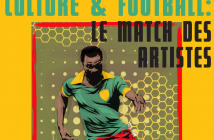Nobody would question the validity of the Aapravasi Ghat as a World Heritage site of utmost importance for Mauritius and the region, and we hope, in a nearby future, beyond the Indian Ocean. Even though much has still to be done to meet its promises and implement fully its buffer zone requirements, one has to admit that through the first three years of its classification by Unesco, the Ghat has acted a a matricial site, in at least two respects.
When the Aapravasi Ghat was added on the World Heritage site list in 2006, many in Mauritius were dubious about its real significance in a multicultural island where the components of the « rainbow nation » have often been pitched again each other. Many deemed that the Ghat’s classification amounted to the recognition of one segment of the Mauritian population, mainly, the Hindus, and that instead of fostering a nation-building impetus, this event would further strengthen the claims of one part of the population as « more historically prone » to benefit from its construction and prosperity. Indeed, the temptation was great to use the site as the justification for one community to « get the lion’s share » by engaging in a « victimising competition » with other sections of the Mauritian population.This temptation, even if it lurks time and oft, has not been the main result of the inscription of the Ghat on the World Heritage list.Instead, much vigilance and wisdom have prevailed. For one part, we authors, historians, artists, semiologists have produced enough counter-narratives and non exclusive poetics to engulf an open approach to otherness. This has been the core of my engagement in fostering the coolitude dynamics into the Ghat. I would just add, that as a result, there is a more polysemic definition attached to the word indentured or coolie, as opposed to its monosemic texture in the past. The indentured comes from a mosaic, as the 2nd November show posited last year : Hindus, Chinese, Muslims, Tamils, Marathis etc were jahaji bhais (brothers and sisters of the ships). I had also brought this semantic shift in earlier articles, that indentured is not ethnical in its core meaning, but judicial (labour with a 5 year contract), that Ethiopians, Japanese, Chinese, Malagasy, Europeans
were also indentured (approaching 5 per cent of the total indentured labour force that was engaged in the « Great Experiment »). Dr S. Peerthum and the historians attached to the site clearly demonstrated this stance, which, if fully understood points to one enduring fact : that even though people of Indian origin formed the bulk of indentured labour, nobody who is objective would contend that indentured labourers were not exclusively Indians. This statistical datum nullifies any exclusive or communal views on indentured labour.
In that sense, the Ghat, while celebrating the Indian component of indentured labour, cannot be the basis of any ethnical construction that would turn a blind eye on the fact that indentured labour was a cosmopolitan experiment that harbingers modern labour migrations in the post-slavery period. And that if India provided the bulk of this form of wage experimentation after slavery, this Indian element cannot turn a blind eye on other human elements, such as the Chinese or other migrations. Our coolitude is at this price. And as such, this indentured paradigm should be thought as a generic experiment engulfing Irish, Polish or any type of migration based on the contract, as the Indian element spearheaded the « Great Experiment ». I would add that, in doing so, we would not belittle the Indian ethos, made of hard work and tolerance, that Mrs Meira, the Indian Minister for Social Justice developed here on 2nd November last year. The Minister also added that openness to other cultures and philosophies is not incompatible with the values of Indianness.
In that sense, the Ghat is matricial in its essence. This open attitude entails that one can view Mauritian History, and modern migrational History in a more diverse, variegated way, fraught with a post-modern, post-structuralist conception, more tuned to comprehend the complexity of multicultural and transcultural processes at work in modern hybrid societies. It offers a humane foundation for the exploration of our History. The Ghat highlights this reality and holds further promises to me.
Acting as the first site to be classified by Unesco in the Mascarene islands, setting the institutional pace and symbolical guideline for Mauritius, the Ghat has been able to inspire an overall global policy aiming at articulating and not opposing specificities of Mauritians. In that respect, when the Morne was inscribed on the WH list, a work on memories was duly set up to link the memory of slavery to indentured labour. I personally made this recommendation in a preliminary committee that met at Parliament for the setting up of Justice and Truth Commission triggered by the Prime Minister and my articles clearly advocated this point to avoid any « competition of memories ». I had discussed about this with Mr Ali Moussa Iyé, Head of the Intercultural Division of Unesco, in order to achieve this unique mission Mauritius could initiate : articulating slavery and indentured narratives and humanities. As the Ghat was classified first, and that indentured labourers were not all Indians, as stated earlier, there was ground to work on this hybrid imaginary of articulating these two paradigms, without impoverishing them, without negating their specificities, but articulating both to bring a sense of awareness that both episodes negated humanity and bore major meanings to nation-building in Mauritius. This nucleus can be extended to other countries, intellectual and social constructions that need the ability to go beyond racial, ethnical or geographical barriers.
The Government has so far been very wise to follow this consensual trend, and I bet it will undoubtedly create a route of memories, going from the Ghat to the Morne, or vice versa, indicating that History is more complex than we think, and that reducing it to one group pitched against each other will just blot out the lessons learned from it.
In that respect, the Ghat is a symbolical matrix, pointing to the fact that indentured labour, even if it resorted massively to Indians and Chinese, was the result of a particular historical context, and more human groups were engaged in it. And that, even if slavery resorted mostly to Africans, the first slaves in Mauritius and La Réunion were of Indian stock. This should be enough to make us read History from a more humane angle, warding off exclusive, sometimes, unjustified views construed from major human tragedies that have framed our coralian, complex, variegated societies.
I believe in this matrix. Recently a group of young Mauritians called The Aapravasi Ghat and le Morne Facebook group contacted me to help them to develop this humanism of diversity, ready to promote a dialogue between these two memories. I think that by promoting this awareness these young persons have proved that through the right decoding of their past, their future is already at hand. And in that dynamics, the Ghat will act as a referent for future constructions so necessary in times beset by speculations of all sorts.









